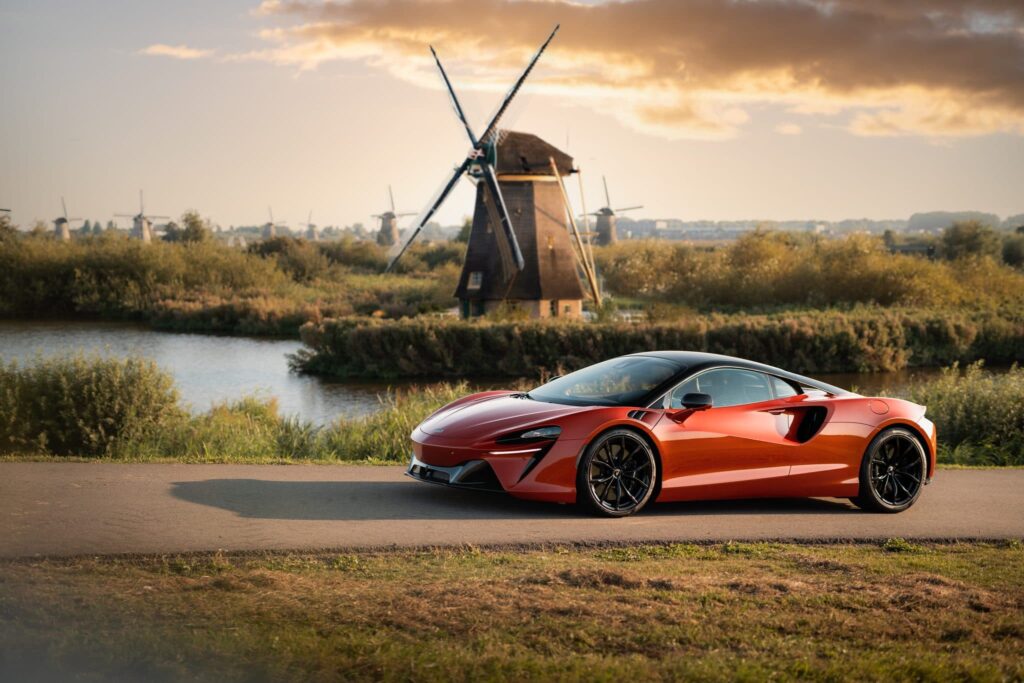
Weight means everything to McLaren, or rather, saving it. The brand consistently builds cars that are among the lightest in their class. That also applies to the Artura, the latest model from Woking.Text: Perry Snijders
Online Editor: Noa Verseveldt
Image: Ansho BijlmakersThe unladen weight of the McLaren Artura is 1,498 kilograms, while the dry weight is even limited to 1,395 kilograms. That makes it the lightest car in its class. Over 140 kilograms lighter than a Porsche 911 Turbo, for one thing. And that's even though the McLaren is a hybrid; with that you usually think of boring, heavy cars. After all, in addition to a gasoline engine, they also lug around an electric motor and a heavy battery. Yet that image is not entirely justified. Sure, there are hybrids where it's true. But it's been years since cars like the McLaren P1, Porsche 918 Spider and LaFerrari proved that a hybrid hypercar is faster than a conventional one with only a combustion engine. In Formula 1, the technology has also proven itself: back in 2009, the first race there was won by a car with a hybrid powertrain - by Lewis Hamilton, in Hungary, to be exact. No wonder the technology is now finding its way into supercars.
You can even drive completely electric with the Artura, although your range is then limited to thirty kilometers. No one will buy an Artura for that reason, but make no mistake: there are car manufacturers who think it is only a matter of time before there will be environmental zones in cities where you can drive exclusively electric. And then it's still convenient that it can be done. Yet that is not the only environmental goal. Supercar manufacturers like McLaren must also meet emission standards. In understandable language: they must reduce the consumption of their cars. This is not only pleasant at the tank, but also in the showroom: in the Netherlands, the purchase tax is based to a considerable extent on emissions. Above all, however, the hybrid powertrain ensures that the Artura's performance far exceeds that of its "predecessor," the 570S. That "predecessor" is in quotation marks: McLaren does not, in fact, see the Artura as a direct replacement for the 570S. The fact is, however, that the latter model is going out of production as the Artura enters the market, so a comparison is obvious. With an output of 680 hp, it has 110 more horsepower. You can accelerate to 100 kilometers per hour in exactly 3.0 seconds. A sprint from standstill to 200 takes you 8.3 seconds, while you go from 0 to 300 in 21.5 seconds. That 21.5 seconds is about the time it took a Mercedes 200D, the cab of the eighties and nineties, to reach 100, to put it a bit in perspective. At 300, by the way, the party is not over yet, as the top speed is 330 kilometers per hour.
The gasoline engine in the Artura is a completely newly developed V6 with 585 horsepower, which is a whopping 19 centimeters shorter than the V8 that McLaren used until now. Of course, that also ensures that the V6 is lighter than the V8, as much as 50 kilograms, one of the reasons why the Artura could remain so light. In an interview, McLaren's head of powertrain, Richard Jackson, even called the low weight the absolute highlight of this engine's greatest achievement. Of course, the Axial Flux E-motor (the electric motor) is also as light as possible. Some brands opt for multiple electric motors, which are then mounted near the wheels, for example. For the lowest possible weight, however, McLaren chose to use just one, which is located in the transmission housing. An additional advantage of that electric motor is that it provides instant throttle response; a gasoline engine must first come up to the right rpm, an electric motor delivers its power immediately.
Those who have reservations about so much new technology, or at all about the reliability of a supercar, will be relieved to read that McLaren offers plenty of security. For example, every Artura comes with a five-year (or 75,000 kilometer) warranty, a six-year (or 75,000 kilometer) battery warranty and a 10-year body warranty (with no mileage limitation). In addition, it comes with five years of roadside assistance. But that's not all: all regular maintenance is also included in the purchase for the first three years. Every 15,000 kilometers (or once a year for those who drive less), the car can be brought in for maintenance, which includes all regular work, such as an oil and oil filter change, new air filters for the combustion engine and e-engine, brake fluid and a comprehensive safety inspection. Only wear parts, such as tires and brakes, are at the customer's expense.
The super-fast Artura is not super-fast in one respect. Delivery should have already begun, but the corona crisis has delayed production, reportedly mainly because suppliers are having problems delivering software and chips. This is extra unfortunate, since we have been eager to drive it since our first introduction in January. Until now, however, our acquaintance was limited to sitting in a stationary car, where all attention could now go to the beautiful materials and design. Designer Robert Melville speaks of a "pure technical sculpture," where the technology is wrapped in a jacket that is not a size too big. We can't contradict him, but by now we also feel like doing what the Artura was made for: driving!
© 2024 MASTERS EXPO. All rights reserved.